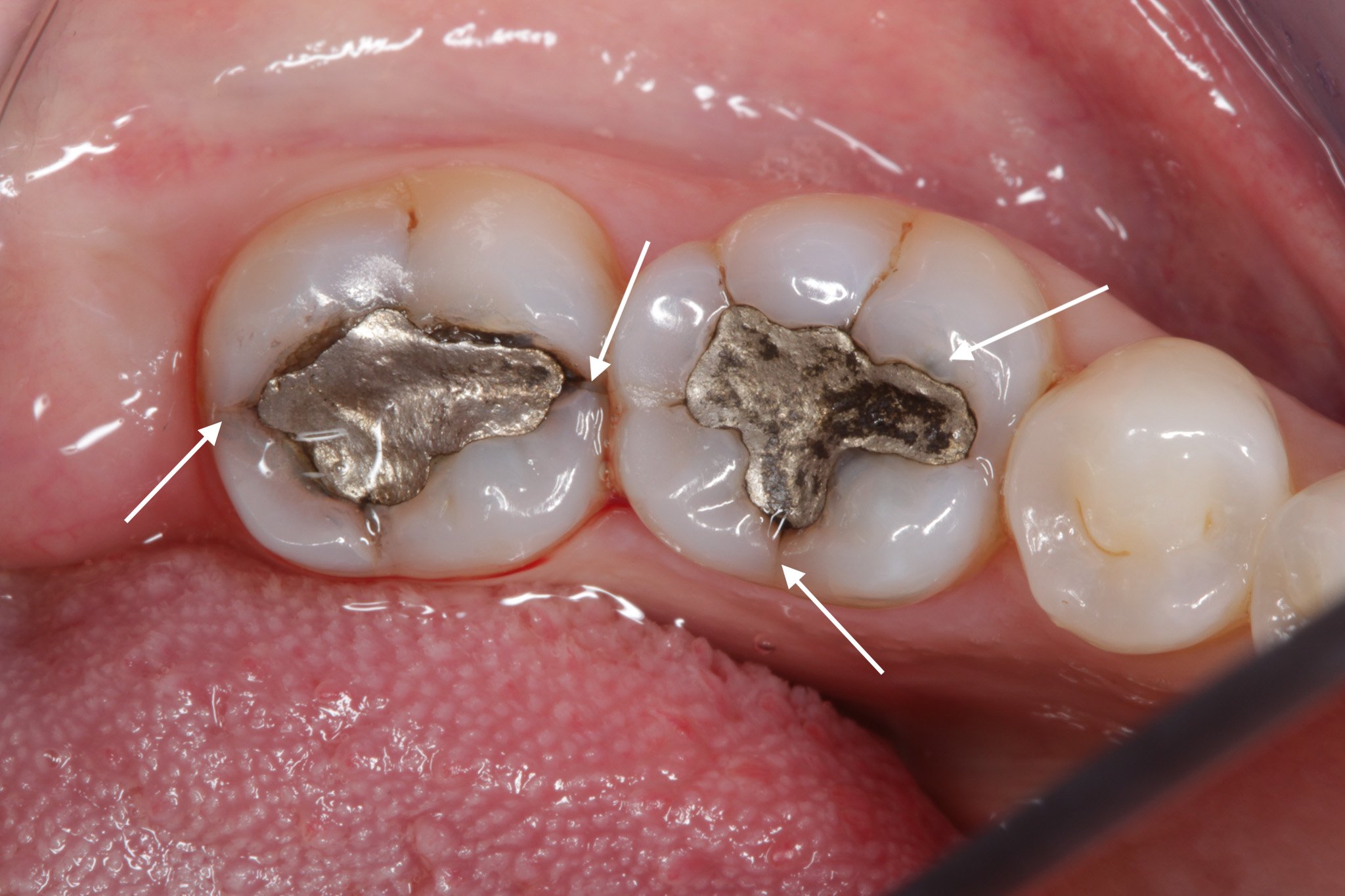The problem with large metal (amalgam) fillings
Big metal fillings have been used for years to restore teeth, but they have a downside. These traditional dental fillings are bad for your teeth and can lead to fractures.
If you have metal fillings, it’s important that you get them assessed and monitored closely by a dentist. In many cases, it may be advisable to replace them with something that will better protect your tooth in the long run. If you want to learn more about your options or speak to one of our online dentists for a consultation, we’re here to help.
A tooth with a large silver filling that has now cracked in half
Why do large metal fillings break teeth?
Amalgam fillings don’t stick to teeth and are held in place by retention. This means your dentist must remove the decay from your tooth and create a cavity for the filling to lock into. Often these cavities and fillings end up being quite large.
Whenever you chew food, you will put pressure on the metal filling, causing it to push against the outer structure of the tooth like a large wedge. If the outer walls of your teeth are too thin or weak, they can crack and fracture over time, resulting in pain.
If this fracture is too deep, then your tooth may need a root canal filling, or it may need to be removed completely.
How to tell if your tooth is at risk of breaking?
Not all metal fillings will cause teeth to break. If your filing is small and well-kept, then there is no harm in keeping it as it is. Your dentist will be able to assess your teeth and decide if your tooth is at a higher risk of breaking. Here are some common signs of a tooth at risk of fracturing.
Cracks developing in the tooth around the filling
Sensitivity from the tooth
Darkening of the tooth
A large filling that leaves thin walls (especially one that goes all the way through a tooth)
A deep filling (you can judge this on an x-ray)
Large silver fillings with small cracks and shadowing in the thin walls of the remaining tooth
How to prevent your tooth from fracturing
It is important to identify high-risk teeth and protect them as soon as possible by replacing the old large fillings with something more suitable for the tooth.
Composite fillings
A composite filling is a tooth-coloured resin filling which is not ‘locked in’ to your cavity like a metal filling but is actually bonded (stuck) to your tooth surface. This bond will help keep the tooth together like a bandage. A large composite filling will be better than a metal one for preventing tooth fracture however it will not eliminate the risk completely.
Porcelain onlays - The ideal option
Over the years, dentistry has seen a remarkable progression regarding the materials and procedures used for restorative purposes. One particularly significant advancement is the change from crowns to onlays when restoring damaged teeth.
Crowns are essentially caps that fully encase the entire tooth, whereas onlays only cover a specific portion that has been damaged or worn away. As such, onlays can be considered partial crowns and offer significant advantages over crowns in many situations.
For instance, onlays require less removal of healthy tooth structure, which protects more of the natural enamel, leading to a longer-lasting restoration. This procedure also helps prevent increased sensitivity due to weakened roots since far less enamel is removed.
Onlays are quickly becoming a preferred solution due to their many benefits. They allow us to give patients long-lasting improvements that cannot be achieved with standard crowns.
Porcelain onlays on the 2 molar teeth
What’s the process of an onlay?
Replacing large fillings with onlays is a simple procedure for a skilled dentist. They will first remove the existing filling and clean the cavity from any decay that is present.
They will then shape the tooth by removing the heights of the tooth to make space for the porcelain onlay.
The dentists will scan your tooth so their lab can print a model and make a custom-fitting porcelain onlay. After scanning your tooth, they will cover it with a temporary onlay.
Your final onlay will be fitted at a follow-up appointment (usually two weeks later).
How much do porcelain onlays cost?
The cost of dental onlays can vary depending on the material and complexity. On average, each dental onlay procedure may cost anywhere from £650 to £1500 per tooth.
Although it may seem like a large expense, you need to consider that you will only need onlays for teeth at risk of breaking, and the cost of replacing a broken tooth with an implant is much higher than an onlay!
Cheaper alternatives to porcelain onlays
If you’re worried about your teeth breaking but can not afford a porcelain onlay, the following options are available:
A composite filling (£150-£300)
A composite onlay (£300 - £500)
A composite filling is a normal tooth-coloured filling which won’t completely protect the tooth from breaking but will be better than a metal one.
Your dentist can make a direct composite onlay over your tooth to protect it from breaking; however, this onlay will not be as smooth or last as long as a proper lab-made porcelain one and will require repairing and replacing more often.
Get advice from our online dentists
If you’re concerned about your dental fillings, contact our online dentists here. We’ll take a look at your teeth remotely and give you an idea about whether or not you need to have them replaced.


